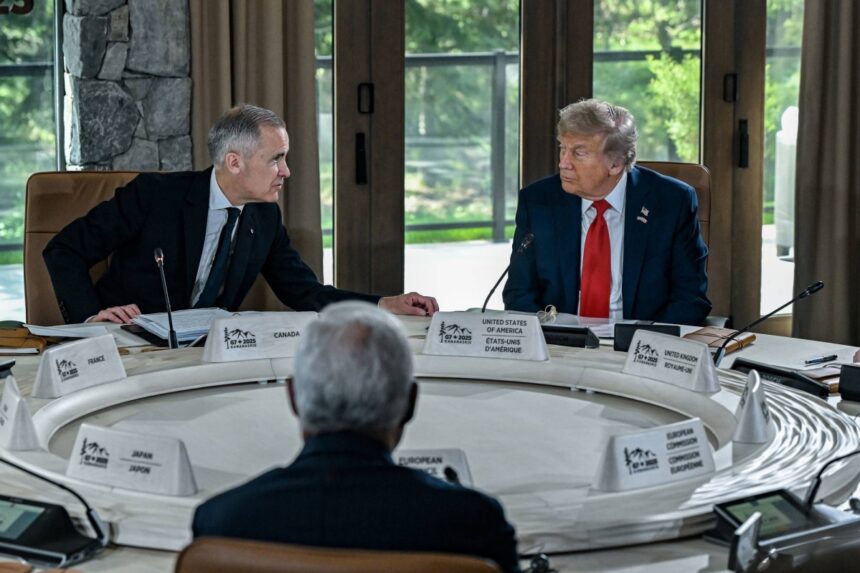Canadian negotiators are facing unprecedented pressure as trade talks with the Trump administration enter their third month, characterized by increasingly demanding terms and shifting goalposts that threaten to upend decades of economic partnership between the two nations.
In what many analysts describe as the most challenging bilateral negotiations in recent history, Canadian Trade Minister Sarah Reynolds admitted yesterday that finding common ground has become “extraordinarily difficult” amid President Trump’s insistence on major concessions across multiple sectors.
“We’re dealing with fundamentally different perspectives on what constitutes fair trade,” Reynolds told reporters following the latest round of talks in Washington. “While we remain committed to maintaining the integrated supply chains that benefit both countries, we cannot accept terms that would devastate key Canadian industries.”
The negotiations, which began in May after President Trump’s executive order mandating a comprehensive review of all trade agreements, have focused particularly on automotive manufacturing, dairy products, and natural resources—sectors where the U.S. administration claims Canada maintains unfair advantages.
Economic forecasts from the Royal Bank of Canada suggest the uncertainty alone has already cost the Canadian economy approximately $3.8 billion in delayed investments and contingency planning. According to their analysis, prolonged negotiations could reduce annual GDP growth by up to 0.4 percentage points if resolved unfavorably.
Industry leaders across Canada have voiced growing concerns about the administration’s approach. “They’re essentially asking us to dismantle supply management systems that have ensured stability for generations of Canadian farmers,” said Jean Bergeron, president of the Dairy Farmers Federation of Canada. “This isn’t negotiation—it’s dictation.”
Perhaps most troubling for Canadian officials is the Trump administration’s apparent willingness to use tariff threats as leverage. Last week, U.S. Trade Representative Marcus Fielding suggested that failure to reach agreement could trigger immediate 25% tariffs on Canadian aluminum and steel exports—reminiscent of measures implemented during Trump’s first term.
“The Americans have adopted what I would call a ‘maximum pressure’ strategy,” explained Dr. Helena Wong, trade policy expert at the University of Toronto. “They’re calculating that Canada’s economic dependence on U.S. markets—roughly 75% of our exports—leaves Ottawa with little choice but to eventually concede on major points.”
Despite these challenges, the Canadian negotiating team has found some limited success in building alliances with U.S. border states whose economies are deeply integrated with Canadian supply chains. Governors from Michigan, New York, and Washington have all publicly urged the administration to pursue more moderate positions.
“Disrupting cross-border trade hurts American workers just as much as Canadians,” Michigan Governor James Henderson stated in a joint letter with other border state governors. “The manufacturing sector in our state depends on components and materials that cross the border multiple times before becoming finished products.”
Public opinion polls suggest Canadians are increasingly anxious about the negotiations’ direction. A recent Ipsos survey found 68% of respondents believe the government should stand firm on protecting key industries, even if it means risking temporary economic pain through tariffs.
Prime Minister Justin Trudeau has attempted to reassure citizens while maintaining a diplomatic tone. “Canada and the United States share the world’s most successful economic relationship,” he said during a speech in Ottawa last week. “We remain confident that reason will prevail, but we’re prepared for all scenarios.”
Economic historians note that the current situation bears troubling similarities to previous periods of trade tension, though with potentially more severe consequences given the depth of economic integration between the two countries. The Canadian dollar has already weakened by nearly 4% against the U.S. dollar since negotiations began, reflecting market concerns.
As talks resume next week in Toronto, the fundamental question remains: can Canada protect its economic sovereignty while maintaining the trade relationship that forms the backbone of its prosperity? The answer will shape North American economic relations for decades to come.
For more coverage on this developing story, visit our sections on Canada News and CO24 Business.

























